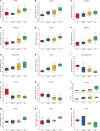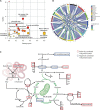Effect of dietary protein content shift on aging in elderly rats by comprehensive quantitative score and metabolomics analysis
- PMID: 36407526
- PMCID: PMC9673908
- DOI: 10.3389/fnut.2022.1051964
Effect of dietary protein content shift on aging in elderly rats by comprehensive quantitative score and metabolomics analysis
Abstract
In the protein nutrition strategy of middle-aged and elderly people, some believe that low protein is good for health, while others believe high protein is good for health. Facing the contradictory situation, the following hypothesis is proposed. There is a process of change from lower to higher ratio of protein nutritional requirements that are good for health in the human body after about 50 years of age, and the age at which the switch occurs is around 65 years of age. Hence, in this study, 50, 25-month-old male rats were randomly divided into five groups: Control (basal diet), LP (low-protein diet with a 30% decrease in protein content compared to the basal diet), HP (high-protein diet with a 30% increase in protein content compared to the basal diet), Model 1 (switched from LP to HP feed at week 4), and Model 2 (switched from LP to HP feed at week 7). After a total of 10 weeks intervention, the liver and serum samples were examined for aging-related indicators, and a newly comprehensive quantitative score was generated using principal component analysis (PCA). The effects of the five protein nutritional modalities were quantified in descending order: Model 1 > HP > LP > Control > Model 2. Furthermore, the differential metabolites in serum and feces were determined by orthogonal partial least squares discriminant analysis, and 15 differential metabolites, significantly associated with protein intake, were identified by Spearman's correlation analysis (p < 0.05). Among the fecal metabolites, 10 were positively correlated and 3 were negatively correlated. In the serum, tyrosine and lactate levels were positively correlated, and acetate levels were negatively correlated. MetaboAnalyst analysis identified that the metabolic pathways influenced by protein intake were mainly related to amino acid and carbohydrate metabolism. The results of metabolomic analysis elucidate the mechanisms underlying the preceding effects to some degree. These efforts not only contribute to a unified protein nutrition strategy but also positively impact the building of a wiser approach to protein nutrition, thereby helping middle-aged and older populations achieve healthy aging.
Keywords: aging; comprehensive quantitative score; dietary patterns; metabolomics; nuclear magnetic resonance.
Copyright © 2022 Zheng, Li, Zhou, Shi, Song, Liao, Zhou, Zheng, Lv and Li.
Conflict of interest statement
The authors declare that the research was conducted in the absence of any commercial or financial relationships that could be construed as a potential conflict of interest.
Figures






Similar articles
-
Exploring the Effects of Changes in Dietary Protein Content on Naturally Aging Mice Based on Comprehensive Quantitative Scoring and Metabolomic Analysis.Nutrients. 2025 Apr 30;17(9):1542. doi: 10.3390/nu17091542. Nutrients. 2025. PMID: 40362850 Free PMC article.
-
Study on plasmatic metabolomics of Uygur patients with essential hypertension based on nuclear magnetic resonance technique.Eur Rev Med Pharmacol Sci. 2014;18(23):3673-80. Eur Rev Med Pharmacol Sci. 2014. PMID: 25535139
-
Biochemical characteristics of different forms of protein-energy malnutrition: an experimental model using young rats.Br J Nutr. 1977 Jan;37(1):1-21. doi: 10.1079/bjn19770003. Br J Nutr. 1977. PMID: 402928
-
[Simple obesity in children. A study on the role of nutritional factors].Med Wieku Rozwoj. 2006 Jan-Mar;10(1):3-191. Med Wieku Rozwoj. 2006. PMID: 16733288 Review. Polish.
-
Amino acids and proteins in relation to the nutrition of elderly people.Age Ageing. 1990 Jul;19(4):S10-24. doi: 10.1093/ageing/19.suppl_1.s10. Age Ageing. 1990. PMID: 2220475 Review.
Cited by
-
Aging immunity: unraveling the complex nexus of diet, gut microbiome, and immune function.Immunometabolism (Cobham). 2025 May 9;7(2):e00061. doi: 10.1097/IN9.0000000000000061. eCollection 2025 Apr. Immunometabolism (Cobham). 2025. PMID: 40352822 Free PMC article. Review.
-
A protein restricted diet induces a stable increased fat storage phenotype in flies.Toxicol Rep. 2023 Jun 7;10:706-713. doi: 10.1016/j.toxrep.2023.06.003. eCollection 2023. Toxicol Rep. 2023. PMID: 37396850 Free PMC article.
-
Caffeic acid modulates intestinal microbiota, alleviates inflammatory response, and enhances barrier function in a piglet model challenged with lipopolysaccharide.J Anim Sci. 2024 Jan 3;102:skae233. doi: 10.1093/jas/skae233. J Anim Sci. 2024. PMID: 39158070 Free PMC article.
-
Longevity-Associated Core Gut Microbiota Mining and Effect of Mediated Probiotic Combinations on Aging Mice: Case Study of a Long-Lived Population in Guangxi, China.Nutrients. 2023 Mar 26;15(7):1609. doi: 10.3390/nu15071609. Nutrients. 2023. PMID: 37049450 Free PMC article.
-
Exploring the Effects of Changes in Dietary Protein Content on Naturally Aging Mice Based on Comprehensive Quantitative Scoring and Metabolomic Analysis.Nutrients. 2025 Apr 30;17(9):1542. doi: 10.3390/nu17091542. Nutrients. 2025. PMID: 40362850 Free PMC article.
References
LinkOut - more resources
Full Text Sources
Research Materials
Miscellaneous

